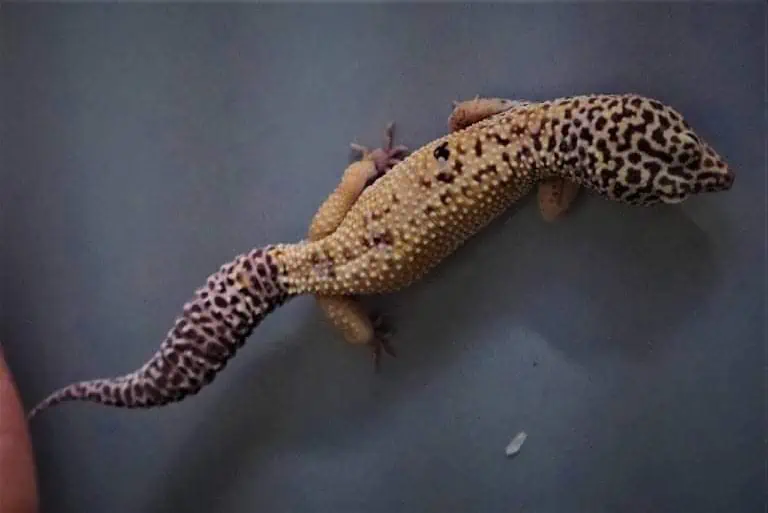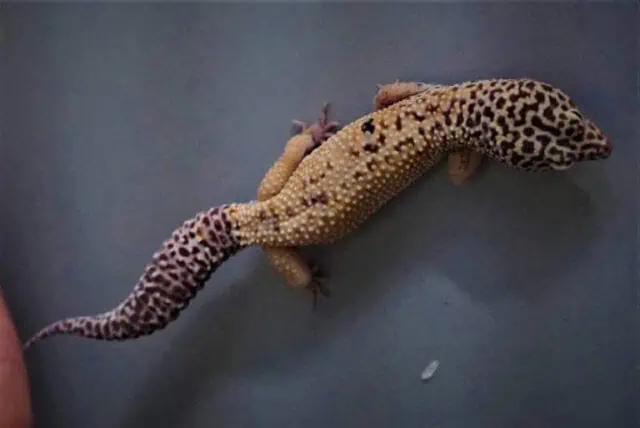Have you ever observed a leopard gecko in action and noticed its tail wiggling or wagging? This intriguing behavior is not just a random quirk but a form of nuanced communication among these reptiles. Tail wagging in leopard geckos serves multiple purposes, from signaling excitement to expressing aggression.
Tail Wagging Significance: Tail wagging in leopard geckos is a multifaceted behavior that communicates various emotions and intentions. Slow tail wagging often signifies curiosity, while fast wagging may indicate excitement or agitation.
Defense Mechanisms: Leopard geckos exhibit defensive tail wagging as a warning sign to potential threats. Should they feel extremely threatened, they can detach their tail as a last-resort escape tactic.
Mating Behavior: Tail wagging can be a sign of mating courtship during the breeding season. Ensure optimal husbandry and maintain environmental conditions between 88-90°F (31-32°C) for successful breeding.
Tail Health: Stress or hostile interactions can result in tail detachment. A lost tail will regrow, but providing a stress-free environment is vital for the gecko’s overall well-being.
Natural Behavior Patterns: Geckos intermittently engage in tail-wagging as part of their natural behavior, aiding in communication and signaling to others in their vicinity.
Why Do Leopard Geckos Wag Their Tails?
Understanding why leopard geckos wag their tails reveals much about their behavioral patterns and communication methods. This distinctive gesture is a unique language in the reptile world, signaling various emotions and intentions.
What is Tail Wagging?
Tail wagging in leopard geckos is a captivating behavior, loaded with meaning and purpose. It’s much more than just a random movement; it’s a vital part of their communication repertoire.
Through varying the speed and manner of their tail wagging, leopard geckos convey distinct messages, expressing emotions, intentions, and reactions to specific situations.
Tail wagging is essentially a form of body language for these creatures, reflecting their responses to their surroundings. Whether it’s a slow, deliberate wag or a fast, abrupt one, each movement holds significance, serving as a silent but clear communication method.
Understanding these different types of behaviors allows us to interpret what a gecko might be feeling or trying to convey, offering insights into their intricate world.
This communicative gesture can be categorized into diverse types, each with its distinctive implications.
Whether signaling excitement, aggression, or defensive mechanisms, tail wagging is a universal language among leopard geckos, allowing them to interact and respond to their environment effectively.
| Type of Tail Wagging | Significance |
|---|---|
| Slow Tail Wagging | Reflects curiosity or a relaxed state. |
| Fast Tail Wagging | Often indicates excitement or agitation. |
| Defensive Tail Wagging | Serves as a warning to potential threats. |
Types of Tail Wagging
While we have established that tail wagging in leopard geckos is a communicative endeavor, it is crucial to recognize that not all wagging is created equal. Diverse types of tail wagging portray different messages, with each type embodying a unique meaning and significance in the realm of gecko communication.
Slow Tail Wagging
Slow tail wagging in leopard geckos is a behavior that is significant in understanding their moods and interactions. This movement is often considered a sign of relaxation or curiosity and is usually displayed in non-threatening situations.
The gentle, unhurried wag of the tail can often be witnessed when a leopard gecko is exploring new surroundings or objects, signaling a calm and interested state. You might see it when it explores a new leash during training, for example.
This type of wagging is distinct from other forms of tail movements due to its relaxed and deliberate pace. It’s a clear reflection of the gecko’s current state of mind, demonstrating contentment or intrigue rather than agitation or fear.
Observing the subtleties in body language associated with slow tail wagging, such as a relaxed posture and unhurried movements, helps in distinguishing it from more frantic or defensive tail actions.
| Behavior | Significance | Cues |
|---|---|---|
| Slow Tail Wagging | Indicates curiosity or relaxation. | Relaxed posture, gentle and deliberate movements. |
Fast Tail Wagging
Fast tail wagging in leopard geckos is another intriguing aspect of their behavioral spectrum, marked by rapid and vigorous movements of the tail. This behavior typically denotes heightened states of emotion, such as excitement or agitation, and is noticeably different from the gentle, slow wagging of a relaxed or curious gecko.
Fast tail wagging often occurs in situations like encountering a potential mate or facing another gecko, reflecting elevated levels of arousal or alertness.
This quick wagging is clearly distinguishable from the slow, deliberate movements associated with calm or exploratory states, as well as from defensive tail wagging that is usually a response to perceived threats. While slow wagging is gentle and measured, fast wagging is brisk and animated, embodying the gecko’s heightened emotional state.
Defensive wagging, on the other hand, is more erratic and usually accompanied by other defensive postures, serving as a warning or deterrent to potential threats.
| Behavior | Significance | Situations |
|---|---|---|
| Fast Tail Wagging | Indicates excitement or agitation. | Encountering mates, facing other geckos. |
Defensive Tail Wagging
Defensive tail wagging is a critical aspect of leopard gecko behavior, serving as a mechanism for self-preservation against potential threats. This behavior is often marked by erratic and abrupt movements of the tail, acting as a clear warning sign to predators or any perceived danger.
When a leopard gecko feels threatened or cornered, defensive tail wagging is deployed as a signal of discomfort or fear, expressing a need for distance and safety.
Leopard geckos utilize this distinct tail behavior as a multifaceted defense mechanism. It not only serves as a deterrent to would-be attackers but also as a diversion, drawing attention away from the more vulnerable parts of their bodies.
There are variations in defensive tail wagging, such as vigorous shaking or side-to-side motions, each conveying different levels of distress or alarm.
| Behavior | Significance | Types | Examples |
|---|---|---|---|
| Defensive Tail Wagging | Acts as a warning to threats. | Vigorous shaking, side-to-side motions. | Encounters with predators, feeling cornered. |
Sign of Excitement
Tail wagging in leopard geckos isn’t always about defense or caution; it can also be a vibrant expression of excitement. Understanding the contexts in which these creatures show such joyful enthusiasm, whether during mating courtship or other engaging activities, allows us to gain a more holistic perspective of their behavioral repertoire.
Mating Courtship
During the breeding season, leopard geckos exhibit a fascinating array of mating courtship behaviors, a vibrant dance of attraction and compatibility. This period is characterized by unique behaviors and displays, with male and female geckos actively participating in the intricate courtship rituals.
Male geckos may showcase more vibrant coloration, wave their tails, and approach females with a distinctive gait, while females exhibit receptivity through body postures and movements.
| Behaviors | Displays | Activities |
|---|---|---|
| Tail waving | Vibrant coloration | Approaching and retreating |
| Distinctive gait | Receptive postures | Subtle body movements and postures |
Different actions such as approaching and retreating, subtle body movements, and respective postures are integral to the courtship process, conveying essential information about their readiness and suitability as mates.
Tail waving is a crucial component of this communicative exchange, symbolizing interest and excitement.
Time to Time Activity
Leopard geckos exhibit tail-wagging not as a constant behavior but as a time-to-time activity, sporadically displaying this intriguing form of communication. Several others could occur, including licking and so on.
It’s a dynamic aspect of their repertoire, occurring intermittently, driven by specific instances or conditions, revealing much about their natural behavior and internal states.
This intermittent behavior can be observed in various contexts, such as when they are exploring new territories, encountering other geckos, or interacting with potential prey.
Each wag of the tail conveys different messages, allowing them to navigate their surroundings effectively, avoid conflicts, and establish social dynamics within their habitat.
| Instances | Natural Behavior | Communication |
|---|---|---|
| Exploring | Alertness | Signaling intent or mood |
| Encountering others | Curiosity | Conveying information |
| Interacting with prey | Responsiveness | Establishing social dynamics |
Sign of Aggression
Leopard geckos, as expressive reptiles, manifest various behaviors that signify aggression. Amongst these, tail-wagging stands out, not merely as a random gesture but as a nuanced communication tool, conveying discontent or unease. Recognizing the signs of aggression in leopard geckos is crucial for keepers to manage interactions and modify the environment suitably to alleviate stress and prevent any potential harm to the geckos.
Defensive Stance and Loud Noise
When leopard geckos feel threatened, they exhibit a defensive stance accompanied by distinct loud noises. This posture includes arching the back and puffing up the body, projecting an image of greater size and strength to ward off potential threats. The noises produced, such as hissing and chirping, act as aural warnings, complementing their physical display in communicating a clear message of discomfort or agitation.
| Behavior | Purpose | Communication |
|---|---|---|
| Arching the back | Display of strength | Warning |
| Puffing up | Intimidation | Distress signal |
| Hissing and chirping | Aural alert | Discomfort indication |
Detached Tail or Tail Loss as a Result of Stress
Leopard geckos can lose their tails as a stress response, a survival tactic known as autotomy, which allows them to escape predators. Stress-induced tail loss can occur for various reasons, such as improper handling, hostile encounters with other geckos, or unfavorable environmental conditions. When a leopard gecko detaches its tail, it is paramount to assess and amend the underlying stressors to prevent further distress and facilitate recovery.
| Stressor | Impact | Preventive Measures |
|---|---|---|
| Improper handling | Tail loss | Gentle, minimal handling |
| Hostile encounters | Injury, stress | Proper housing, separation |
| Unfavorable conditions | Stress, poor health | Optimal habitat conditions |






